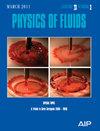Effects of axisymmetric confinement on vortical structures emanating from round turbulent jets
IF 4.3
2区 工程技术
Q1 MECHANICS
引用次数: 0
Abstract
Confined jets occur in many engineering applications including combustion chambers, jet pumps, and chemical reactors. The effects of axisymmetric confinement on the vortical structures identified in a turbulent jet are investigated using large eddy simulation at a Reynolds number of 30 000 (based on nozzle exit conditions) and expansion ratio (chamber-to-nozzle diameter ratio) of five. The results obtained from the confined jet are compared with those of a free jet under the same nozzle exit flow conditions. A prominent recirculation zone forms between the expanding jet and the confining wall, resulting in early shear layer distortion and a shorter interaction length in the confined jet (0.85 jet diameters) compared to the free jet (1.15 jet diameters). Using the λ2 criterion for vortex identification, two dominant structural modes are identified in the near-exit region of the free jet: ring and helical modes. However, in the confined jet, the helical mode is absent, and the turbulent confined fluid accelerates the breakup of the ring vortices. The interaction of the secondary line vortices with the breaking structures leads to the formation of new hairpin-like vortices, which also contribute to further vortex breakup. These results explain the enhanced mixing performance of confined jets as the mixing is directly tied to the breakup of large vortical structures. Proper orthogonal decomposition modes are also presented to identify the structures/events with the highest contribution to the total turbulent kinetic energy in both flow fields.轴对称约束对圆形湍流喷流涡旋结构的影响
密闭射流在许多工程应用中都会出现,包括燃烧室、喷射泵和化学反应器。在雷诺数为 30 000(基于喷嘴出口条件)和膨胀比(腔室与喷嘴直径比)为 5 的条件下,使用大涡流模拟研究了轴对称约束对湍流射流中识别出的涡流结构的影响。在相同的喷嘴出口流动条件下,将封闭射流与自由射流的结果进行了比较。在膨胀射流和约束壁之间形成了一个突出的再循环区,导致早期剪切层变形,与自由射流(1.15 射流直径)相比,约束射流的相互作用长度(0.85 射流直径)更短。使用 λ2 标准进行涡流识别,在自由射流的近出口区域识别出两种主要结构模式:环形模式和螺旋模式。然而,在约束射流中,螺旋模式不存在,湍流约束流体加速了环形涡旋的破裂。次级线涡旋与断裂结构的相互作用导致形成新的发夹状涡旋,这也有助于涡旋的进一步断裂。这些结果解释了约束射流混合性能增强的原因,因为混合与大型涡旋结构的破裂直接相关。此外,还提出了适当的正交分解模式,以确定在两个流场中对总湍动能贡献最大的结构/事件。
本文章由计算机程序翻译,如有差异,请以英文原文为准。
求助全文
约1分钟内获得全文
求助全文
来源期刊

Physics of Fluids
物理-力学
CiteScore
6.50
自引率
41.30%
发文量
2063
审稿时长
2.6 months
期刊介绍:
Physics of Fluids (PoF) is a preeminent journal devoted to publishing original theoretical, computational, and experimental contributions to the understanding of the dynamics of gases, liquids, and complex or multiphase fluids. Topics published in PoF are diverse and reflect the most important subjects in fluid dynamics, including, but not limited to:
-Acoustics
-Aerospace and aeronautical flow
-Astrophysical flow
-Biofluid mechanics
-Cavitation and cavitating flows
-Combustion flows
-Complex fluids
-Compressible flow
-Computational fluid dynamics
-Contact lines
-Continuum mechanics
-Convection
-Cryogenic flow
-Droplets
-Electrical and magnetic effects in fluid flow
-Foam, bubble, and film mechanics
-Flow control
-Flow instability and transition
-Flow orientation and anisotropy
-Flows with other transport phenomena
-Flows with complex boundary conditions
-Flow visualization
-Fluid mechanics
-Fluid physical properties
-Fluid–structure interactions
-Free surface flows
-Geophysical flow
-Interfacial flow
-Knudsen flow
-Laminar flow
-Liquid crystals
-Mathematics of fluids
-Micro- and nanofluid mechanics
-Mixing
-Molecular theory
-Nanofluidics
-Particulate, multiphase, and granular flow
-Processing flows
-Relativistic fluid mechanics
-Rotating flows
-Shock wave phenomena
-Soft matter
-Stratified flows
-Supercritical fluids
-Superfluidity
-Thermodynamics of flow systems
-Transonic flow
-Turbulent flow
-Viscous and non-Newtonian flow
-Viscoelasticity
-Vortex dynamics
-Waves
 求助内容:
求助内容: 应助结果提醒方式:
应助结果提醒方式:


